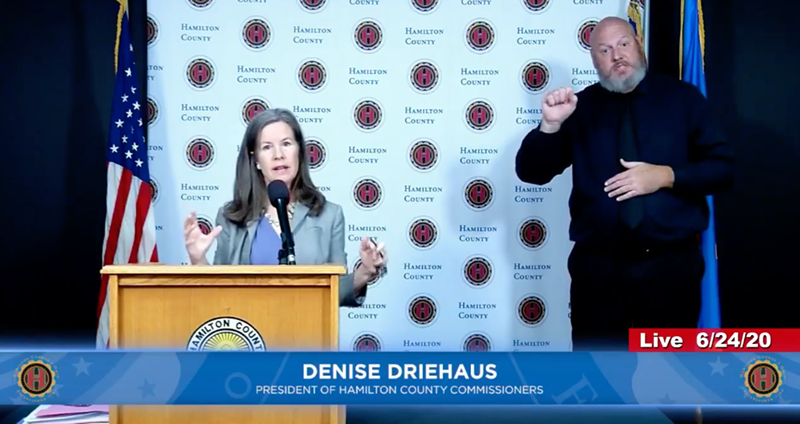Hamilton County Commissioner Denise Driehaus opened her press briefing on Wednesday with these words: “I’m saddened to report that Hamilton County is seeing its biggest spike in new cases since the COVID-19 crisis began.”
Today, the county has 4,098 positive cases, 665 hospitalizations, 188 deaths and 851 recoveries.
Greg Kesterman, Interim Health Commissioner for Hamilton County Public Health, said the current reproductive number — or the amount of people one person infected with COVID-19 will infect — for the county is 1.62.
“If (the reproductive number) is over 1, an outbreak will continue to spread. If a reproductive number falls below 1, the outbreak will begin to slow down," he said. "This morning, the reproductive number for Hamilton County is 1.62. For reference, last week when I was here, it was 1.45. Also, for the region, it is 1.50 this morning. And last week when I was here, it was 1.10.”
Driehaus said part of the reason for the uptick is, yes, more people are getting tested and being diagnosed. Kesterman said on Monday alone, Hamilton County had 114 new cases to contract trace.
“However, the recent spike is too large to be explained by just (testing) alone," Driehaus said.
“We are absolutely seeing more hospitalizations and intensive care unit admissions,” Kesterman said. “We know that if testing is showing more cases, the real numbers that are concerning to us are when hospitalizations increase. Testing has no impact whatsoever on hospitalizations.”
Christa Hyson, external relations with Health Collaborative, said that the county has seen a net increase of four to five hospitalizations per day over the past 12 days.
"From Monday the 22nd to just yesterday, in Southwest Ohio the number of COVID patients in our region’s hospitals went up 6.4% and the number of ICU patients increased by 17.1%,” she said during the press briefing. "To give you a clear picture, two weeks ago we had 65 hospitalized COVID patients. Now we have almost 120."
She said those in the 20 to 30 age range were seeing the largest increase in confirmed cases, which is concerning because they are the most mobile and the most likely to spread the virus.
Zip Codes 45231 and 45240 — Forest Park, Springfield Township, Mt. Healthy, North College Hill — have been particularly hard hit with the recent increase. A third Zip Code, 45238, is also a concern, but Kesterman said that area is a hot spot due to coronavirus infections in nursing homes.
“In Zip Codes 45231 and 45240, we’re seeing an increase in cases among the younger population. These cases are not associated with nursing homes; these are community-spread cases,” Kesterman said. “These are the result of people interacting in their daily lives — going to the grocery, playing baseball games and sitting too close to people. These types of things spread COVID-19 and really need each of us to take seriously and each of us to do our part to help slow the spread of COVID-19."
Kesterman and Driehaus both said that there has also been a noted uptick in cases in the Black and Hispanic communities and they are working with partner organizations to make sure they are getting the message out that there's "a real concern here in Hamilton County" about the coronavirus.
“The message is the same: Mask up. Stay away from each other, if you can, and wash your hands," Driehaus said. "We suspect that people have gotten relaxed. We were doing such a great job with this but unfortunately the suspicion is that people have kind of let their guard down. We need to ramp this behavior back up and make sure we’re doing our part to keep people safe. So behave as though you have the virus and everyone around you has the virus.”
The county is using $19 million from the CARES Act to roll out new testing locations. Those locations will be activated in the next 30 days or so, said Driehaus, and will complement the current National Guard pop-ups from the state. Six no-cost National Guard pop-ups will be coming to the most affected Zip Codes soon; info will be shared today or tomorrow about those testing locations.
“Now is not the time to stop fighting COVID-19. We’re going to be living with this throughout the rest of this year," Kesterman said. "There’s no vaccine. There’s no cure. The way that we fix it is by working as a team and doing prevention.”






